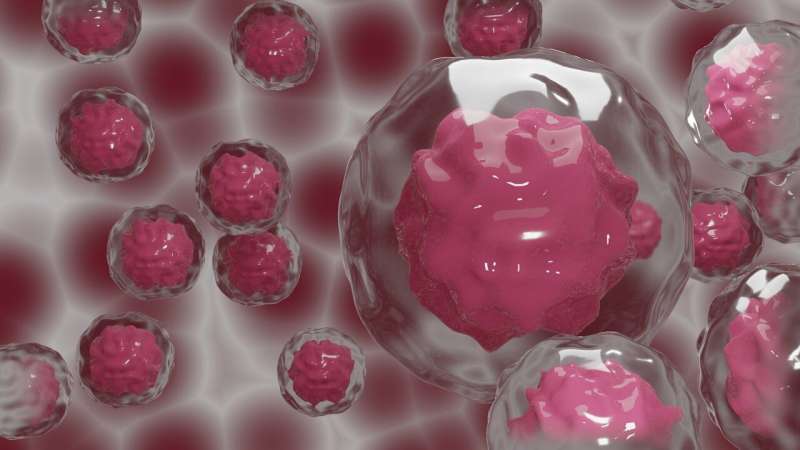Immune cells more susceptible to being suppressed allow acceptance of transplanted organs

Patients who receive organ transplants must take powerful medications to prevent the immune system from rejecting the organ. Unfortunately, these drugs can cause a host of serious side effects and increase the risk of infections from viruses and bacteria, so researchers continue searching for ways to allow the immune system to accept a new organ while maintaining its normal functions.
In a new study published this week in the Proceedings of the National Academy of Sciences, researchers from the University of Chicago showed that in a model of mice that have full transplant tolerance, immune T cells that would normally attack the transplanted organ are more susceptible to suppression by regulatory T cells because they downregulate expression of a key transcription factor. The research explains a new mechanism as to why some animals rejected transplants while others achieve full acceptance, which could provide a potential target to improve transplant survival in humans.
The mice used in these experiments were given a short-term treatment called co-stimulation blockade that allowed them to accept a heart transplant permanently, without having to continue immunosuppression drugs. Maria Luisa-Alegre, MD, Ph.D., Professor of Medicine at UChicago, and Anita Chong, Professor of Surgery at UChicago, co-senior authors of the new study, wanted to dig deeper into what was happening in these mice to allow them to tolerate the new organ so well.
"If we can achieve transplantation tolerance in mice, we want to understand when this is successful, how is the immune system altered?" Alegre said. "And if we understand that, we may be able to design new therapies to be able to achieve transplantation tolerance in humans too."
T cells help the immune system fight infections and other foreign invaders. They come in many different flavors, including CD4+ T cells, which coordinate the immune response by stimulating other immune cells, such as macrophages, B cells, and other types of T cells. Among CD4+ T cells, there are two more subsets; conventional T cells help other immune cells, while regulatory T cells (commonly known as Tregs) shut down the conventional T cells at the end of an immune response.
Normally these cells work in concert to first ramp up the response to a virus or pathogenic bacteria, then shut down smoothly once the infection clears. Unfortunately, these cells recognize a transplanted organ as a foreign invader too and respond the same way. So, scientists are trying to figure out how to prevent this response to a transplant without having to suppress the entire immune system indefinitely.
A few years ago, Alegre and her team took transplant-specific conventional T cells from the mice that accepted heart transplants and sequenced their RNA. This would let them see what genes were active and being expressed, and perhaps provide a clue for how the mice were able to tolerate the new organ. They eventually zeroed in on one gene that was known to play a role in the immune response to cancerous tumors, a transcription factor called Satb1. In the cancer response, and during rejection of a transplanted organ, this gene is upregulated, or expressed more, but in the transplant tolerant mice, it was downregulated, i.e., it was expressed less.
"That made sense, because what we want to achieve in transplantation versus cancer is a mirror image," Alegre said. "Cancer researchers try to rev up the immune system to reject cancers, but we want to turn down the immune system so the transplants are not rejected."
They first thought the downregulated Satb1 would impair conventional T cell function, explaining why those mice accepted the transplants, but it turned out to be not so simple. They tested another set of mice that had Satb1 knocked out in conventional T cells, making it nonfunctional, expecting this to allow those mice to accept transplants. But they also rejected new organs, just like mice with intact Satb1. However, when the researchers added a small number of Tregs, the mice did accept the organ. This suggested that while the conventional T cells functioned just fine either way, the lack of Satb1 made them more susceptible to being switched off by Tregs.
Alegre said that this finding is still pretty far away from being able to be translated into new treatments for humans, but it does give them insight as to what exactly transplant tolerance looks like at the immune cell level. Perhaps one day this could be incorporated into a new, more precise immunosuppression regimen.
"It reveals two things. One thing that was not known, which is that a transcription factor tunes up and down the susceptibility of conventional T cells to suppression by Tregs," she said. "And two, it reveals another component of transplantation tolerance that maybe we can exploit to try and make transplantation tolerance more robust."
The study, "Reduced Satb1 expression predisposes CD4+ T conventional cells to Treg suppression and promotes transplant survival," is published in the Proceedings of the National Academy of Sciences.
More information: Reduced Satb1 expression predisposes CD4+ T conventional cells to Treg suppression and promotes transplant survival, Proceedings of the National Academy of Sciences (2022). DOI: 10.1073/pnas.2205062119




















